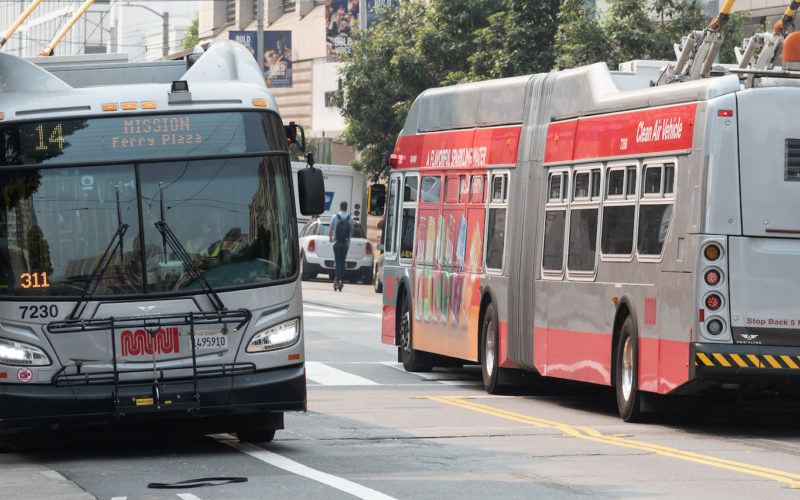

TDM can look like this: Members of the Frogtown Crew led community forums on biking and walking in 2013. Image: St. Paul Smart Trips.
Transportation demand management (TDM), a suite of programs that encourage sustainable transportation, has traditionally been focused on the commute to and from work. In fact, the primary trade group representing the TDM industry is called the Association for Commuter Transportation. Yet at ACT’s 2014 conference, which I attended in San Francisco earlier this month, some of the most compelling programs looked beyond the workplace.
In the Twin Cities, St. Paul Smart Trips is encouraging sustainable transportation in a diverse, working-class neighborhood called Frogtown. Program staff are letting community organizations and youth (who call themselves the “Frogtown Crew”) lead the way on activities like door-to-door and community outreach aimed at identifying barriers to walking and biking. The program’s impacts have included non-traditional benefits like developing community leadership, with two of the Crew becoming members of their neighborhood association’s board of directors. Similar work is being performed in Chicago’s Bronzeville neighborhood, where city ambassadors have performed outreach in ways that are relevant to the neighborhood, visiting churches and senior centers, and organizing walking and biking events centered around local landmarks.
In the Bay Area, the civic group TransForm has launched a “GreenTRIP” certification program for residential developers. By building fewer parking spaces and providing 40 years of discounted transit passes or carshare memberships for tenants, developers can win environmental recognition – and economic benefit. As TransForm’s materials show, providing four decades of discounted transit passes is still $15,000 cheaper than building a parking space in a garage. The first five certified projects represented 1,970 housing units, packaged with 600 carshare memberships and 2,010 transit passes (representing $175,000 in annual revenue for area transit agencies). Residents are projected to drive 60% fewer miles than the average for the region.

A GreenTRIP-certified housing development in Hayward, California. Image: HUD via Eden Housing.
But if there was good evidence that the TDM field has moved beyond its traditional workplace origins, a different barrier seemed apparent. Integration of transit and TDM remains uneven across the country, and I didn’t find many transit agency staffers at the ACT Conference, even though TDM and transit go hand in hand. That message was reinforced by TransitCenter executive director David Bragdon’s keynote presentation on the second day of the conference. His presentation offered a preview of a forthcoming national survey from TransitCenter examining what makes Americans choose to ride transit, generational and regional differences in use of transit, and more..
One of the central findings of the research is that across age groups, the most important factors dictating whether or not someone uses transit are service reliability, travel time, access to stations, and cost. Effective TDM measures can change these factors. A resident who gets a discounted transit pass obviously has a powerful incentive to try the bus. Employer shuttles can increase access to transit stations in places where it is lacking. And a “guaranteed ride home” program reimburses taxi rides for an employee who needs to leave work at an unexpected time, when transit service may not be running; from the rider’s perspective this makes transit a more reliable option, even though it doesn’t directly improve the reliability of the transit service itself.
For transit planners, a useful analogue might be bicycle and pedestrian planning. In recent years, planners have come to understand that building biking and walking connections between transit stations and key destinations can significantly boost transit ridership by solving the “first and last mile” problem. Transit agencies should think of TDM in the same way: It might not be their traditional core business, but a strong TDM program can bring in new business. Meanwhile, in the same way that TDM innovators are demonstrating the field’s benefits for neighborhoods and developers, they can do more to prove to transit agencies that there is value in strong partnerships.
 On the Brink: Will WMATA’s Progress Be Erased by 2024?
On the Brink: Will WMATA’s Progress Be Erased by 2024?
The experience of being a WMATA rider has substantially improved over the last 18 months, thanks to changes the agency has made like adding off-peak service and simplifying fares. Things are about to get even better with the launch of all-door boarding later this fall, overnight bus service on some lines starting in December, and an ambitious plan to redesign the Metrobus network. But all of this could go away by July 1, 2024.
Read More What’s Going on With Transit Service at the Seven Highest Ridership U.S. Cities? SF Edition
What’s Going on With Transit Service at the Seven Highest Ridership U.S. Cities? SF Edition
As of March 2022, SFMTA was operating 88% of pre-pandemic service and added back even more service in July.
Read More